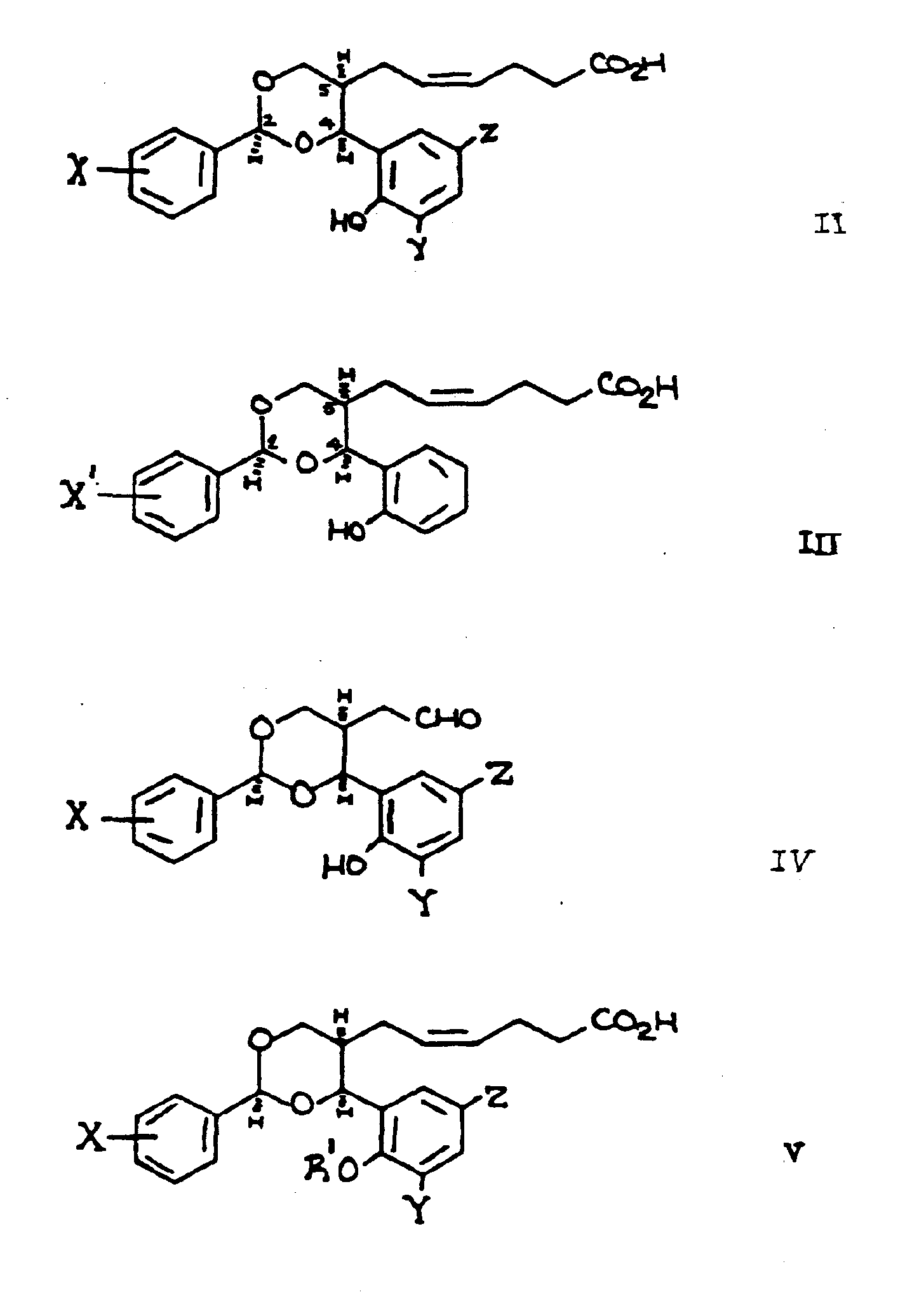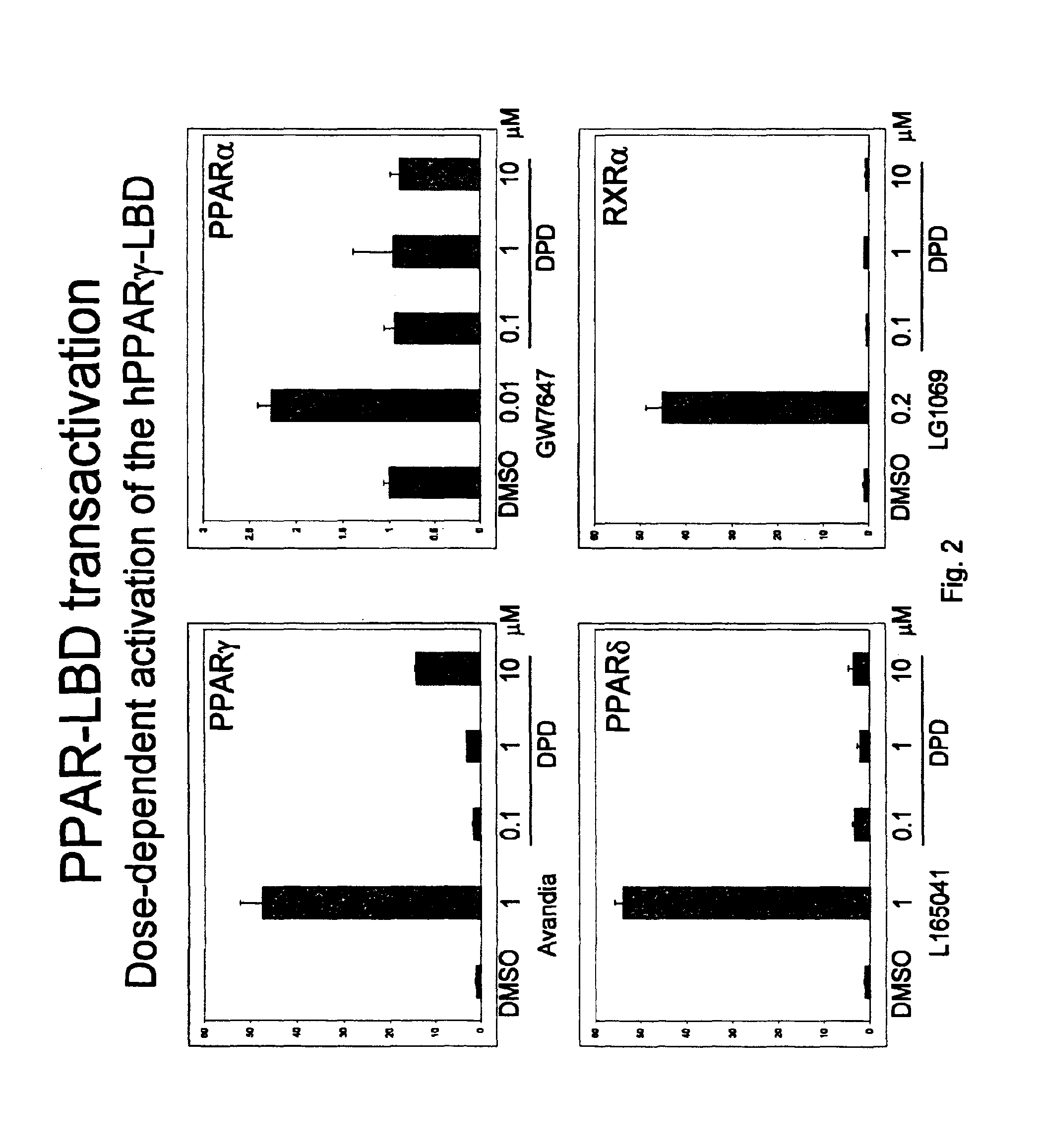PPAR Modulators
a technology of ppar and modulator, which is applied in the field of ppar modulators, can solve problems such as unsatisfactory treatmen
- Summary
- Abstract
- Description
- Claims
- Application Information
AI Technical Summary
Benefits of technology
Problems solved by technology
Method used
Image
Examples
example 1
Synthesis of 4-(Z)-6-(2-o-chlorophenyl-4-o-hydroxyphenyl-1,3-dioxan-cis-5-yl)hexenoic acid
[0162]This example describes the synthesis of 4-(Z)-6-(2-o-chlorophenyl-4-o-hydroxyphenyl-1,3-dioxan-cis-5-yl) hex-enoic acid, also referred to herein as DPD, according to Scheme 2 (SN1 in Table II).
[0163]Synthesis of 2-methoxy-paraconic acid (2-3): A 20 L double-jacketed glass reactor was charged with 260 g o-methoxybenzaldehyde, 286 g succinic anhydride, 572 g anhydrous zinc chloride and 2600 mL anhydrous DCM. The mixture was stirred and cooled to 2° C. An amount of 533 mL triethylamine was added over a period of 30 min. The mixture was then allowed to stir at ambient temperature for 24 h. An amount of 1690 mL 2M HCl was added, followed by 2600 mL ethyl acetate. The mixture was stirred vigorously for 5 min. The aqueous phase was extracted with 2000 mL ethyl acetate. The combined organic extracts were washed with 650 mL saturated brine, followed by a wash with 3×2600 mL saturated sodium bicarb...
example 2
Synthesis of PPAR Modulator 2 (SN2, Table II)
[0181]This example describes the synthesis of PPAR modulator 2 (SN2, Table II) according to Scheme 3. An amount of 100 mg (0.31 mmol) racemic acetonide (6-[4-(2-hydroxyphenyl)-2,2-dimethyl-[1,3]dioxan-5-yl]-hex-4-enoic acid) 2-12 as described in Example 1. was mixed with 1 mL toluene and 10 mg p-toluenesulfonic acid. To the mixture was added 2 eq (0.62 mmol, 108 mg) of 2,3-dichlorobenzaldehyde. The mixture was stirred for 24 h and evaporated using a nitrogen flow. The crude reaction mixture was purified over a silica gel column, using methanol(1) / DCM(19). Pure fractions were identified by TLC, collected, evaporated and analyzed by HPLC and mass spectrometry.
[0182]Mass spectrum (electrospray, negative mode): [M−H]−=435
example 3
Synthesis of PPAR Modulator 6 (SN6, Table II)
[0183]This example describes the synthesis of PPAR modulator 6 (SN6, Table II) according to Scheme 3. An amount of 100 mg (0.31 mmol) racemic acetonide was mixed with 1 mL toluene and 10 mg p-toluenesulfonic acid. To the mixture was added 2 eq (0.62 mmol, 70 mg) of cyclohexanone. The mixture was stirred for 24 h and evaporated using a nitrogen flow. The crude reaction mixture was purified over a silica gel column, using methanol(1) / DCM(19). Pure fractions were identified by TLC, collected, evaporated and analyzed by HPLC and mass spectrometry.
[0184]Mass spectrum (electrospray, negative mode): [M−H]−=359
PUM
| Property | Measurement | Unit |
|---|---|---|
| Electric charge | aaaaa | aaaaa |
| Electric charge | aaaaa | aaaaa |
| Electric charge | aaaaa | aaaaa |
Abstract
Description
Claims
Application Information
 Login to View More
Login to View More - R&D
- Intellectual Property
- Life Sciences
- Materials
- Tech Scout
- Unparalleled Data Quality
- Higher Quality Content
- 60% Fewer Hallucinations
Browse by: Latest US Patents, China's latest patents, Technical Efficacy Thesaurus, Application Domain, Technology Topic, Popular Technical Reports.
© 2025 PatSnap. All rights reserved.Legal|Privacy policy|Modern Slavery Act Transparency Statement|Sitemap|About US| Contact US: help@patsnap.com



